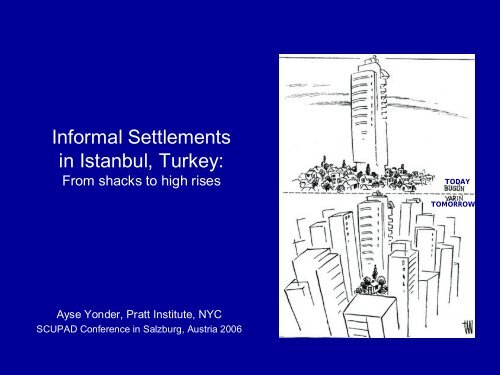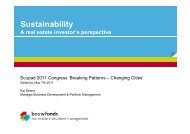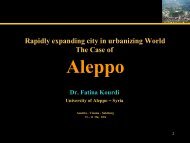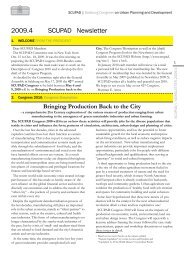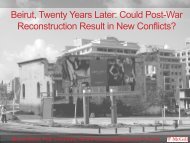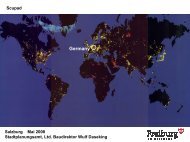Informal Settlements in Istanbul, Turkey: - SCUPAD
Informal Settlements in Istanbul, Turkey: - SCUPAD
Informal Settlements in Istanbul, Turkey: - SCUPAD
Create successful ePaper yourself
Turn your PDF publications into a flip-book with our unique Google optimized e-Paper software.
<strong>Informal</strong> <strong>Settlements</strong><br />
<strong>in</strong> <strong>Istanbul</strong>, <strong>Turkey</strong>:<br />
From shacks to high rises<br />
TODAY<br />
TOMORROW<br />
Ayse Yonder, Pratt Institute, NYC<br />
<strong>SCUPAD</strong> Conference <strong>in</strong> Salzburg, Austria 2006
A dynamic and <strong>in</strong>tegral part of the urbanization process<br />
cannot be understood <strong>in</strong> isolation from what is<br />
happen<strong>in</strong>g <strong>in</strong> the rest of the city and society
a place to take root <strong>in</strong> the city,
… jobs, a community of networks,<br />
(Gazi, Zeyt<strong>in</strong>burnu 1982)
shelter -- an <strong>in</strong>vestment that would ga<strong>in</strong> value over time<br />
(Gulsuyu 1982,<br />
1990)
• Background: unequal development and rapid rates of<br />
urbanization <strong>in</strong> <strong>Turkey</strong><br />
• Development of <strong>Informal</strong> <strong>Settlements</strong> <strong>in</strong> <strong>Istanbul</strong><br />
– 1945-1960<br />
– 1960-1980<br />
– 1980 +<br />
• Current issues + opportunities, future problems
Map of <strong>Turkey</strong> – regions & <strong>Istanbul</strong>
Historic Growth
Traditional spatial organization of neighborhoods <strong>in</strong> the<br />
historic core
Area<br />
57,120 ha<br />
Density 1,928 pe / sq.km<br />
(*)<br />
POPULATION<br />
<strong>Turkey</strong> <strong>Istanbul</strong> %<br />
2000 67,803,900 10,018,700 14.8%<br />
1990 56,473,000 7,196,800 12.7%<br />
1980 44,737,000 4,741,900 10.6%<br />
1970 35,605,200 3,019,000 8.5%<br />
1960 27,855,000 1,882,100 6.8%<br />
1950 20,947,200 1,166,500 5.6%<br />
1940 17,821,000 991,200 5.6%<br />
1935 16,158,000 883,600 5.5%<br />
1927 13,650,000 606,900 4.4%
Spatial plann<strong>in</strong>g efforts - early years of the Republic<br />
Development of railroad system<br />
Industrial complexes +<br />
Cultural centers<br />
1923-<br />
1935<br />
1890-<br />
1923<br />
1935-<br />
1945
Unequal regional growth<br />
Source: SSI of <strong>Turkey</strong> 2001<br />
% of manufactur<strong>in</strong>g workers <strong>in</strong><br />
<strong>Turkey</strong><br />
Per capita Gross Domestic Product<br />
$<br />
% Unemployment (pop. > 12 yrs<br />
old)
Settled areas, <strong>in</strong>dustry, highways, and City fresh water reservoirs<br />
E-5<br />
E-5
<strong>Informal</strong> <strong>Settlements</strong>
Types of <strong>in</strong>formal settlement processes:<br />
1. Squatter hous<strong>in</strong>g = Gecekondu (landed overnight)<br />
Legal def<strong>in</strong>ition: unauthorized construction on someone else’s land<br />
2. <strong>Informal</strong> Subdivision = Hisseli Tapu (shared title deed) OR<br />
Ozel Ifraz (private subdivision)<br />
Shared title deed is legal accord<strong>in</strong>g to the Civil Law but both the<br />
subdivision and construction are aga<strong>in</strong>st the Reconstruction Law
1946-1960: Formation of first settlements<br />
Context:<br />
• Multi-party system – 1946<br />
• Economic liberalization policies + high <strong>in</strong>flation real estate++<br />
• Marshall Aid + mechanization <strong>in</strong> agriculture migration to cities<br />
• Inner city public works projects dislocation of many residents<br />
• Government unable/reluctant to subsize hous<strong>in</strong>g<br />
Attitudes & Policy Response:<br />
• Media image mixed: “cancerous growth,” “poor migrants”<br />
• Some employers support their workers to build gecekondu<br />
• 1949 gecekondu law (1 st ) frequent demolitions<br />
• 1953 Law – consolidation of exist<strong>in</strong>g gecekondu<br />
• 1956 Reconstruction law – new rules re. subdivision size/services<br />
Gecekondus <strong>in</strong>crease from 5,000 (1949) to 60,000 (1960)<br />
<strong>Informal</strong> subdivisions emerge as an alternative
Gradual occupation of<br />
public land + land-<strong>in</strong>dispute<br />
Located on steep slopes,<br />
near highways, and<br />
undesirable land
Located near<br />
places of<br />
employment
Lack of basic <strong>in</strong>frastructure services
1960-1980: Expansion and Establishment<br />
Context:<br />
• Military coups <strong>in</strong> 1960 & 1970; weak coalition governments<br />
• 1961 Constitution – expanded democratic freedoms, hous<strong>in</strong>g right<br />
• Economic growth + high <strong>in</strong>flation rates<br />
• Accelerated rates of migration to cities <strong>in</strong> 1970s<br />
• Five-year Development Plans + gov’t hous<strong>in</strong>g <strong>in</strong>vestments 50%
<strong>Informal</strong> settlements <strong>in</strong> <strong>Istanbul</strong>
Gecekondu Law provided<br />
<strong>in</strong>frastructure services to<br />
“Upgrad<strong>in</strong>g” areas – but few titles<br />
Squatters have to purchase land<br />
from local power groups; liberated<br />
zones emerge
<strong>Informal</strong> subdivisions:<br />
mostly on rural land around<br />
the city (village greens,<br />
private farmland, land<br />
allocated to Balkan<br />
immigrants, etc)<br />
Once development takes<br />
place, new municipality<br />
formed (services, ad hoc<br />
master plan, legalization)
<strong>Informal</strong> subdivison documents:<br />
Shared title deed<br />
+ subdivision map<br />
Public Notary agreement<br />
Construction<br />
of<br />
foundations
F<strong>in</strong>anc<strong>in</strong>g of construction:<br />
1) purchase of a larger lot than needed – sell the rest later
2) construction over time<br />
3) tenants f<strong>in</strong>ish construction <strong>in</strong> lieu of pay<strong>in</strong>g rent
Pollution
Inadequate <strong>in</strong>frastructure
Lack of<br />
open<br />
space
Transportation System -<br />
m<strong>in</strong>ibuses
Uncoord<strong>in</strong>ated “private” subdivisions + streets
Context:<br />
1980 + : Urban Transformation starts<br />
• Military regime 1980-83; new Constitution<br />
• Military conflict <strong>in</strong> SE forced migration to cities –w/o resources<br />
• IMF dictated economic stabilization program Soar<strong>in</strong>g rates of<br />
<strong>in</strong>fllation <strong>in</strong> 1980s; wage levels decl<strong>in</strong>e<br />
• Local government reform: revenues <strong>in</strong>creased; plann<strong>in</strong>g power<br />
decentralized to local level; <strong>in</strong>frastructure provision centralized<br />
• Islamic movement captures municipalities 1994; w<strong>in</strong>s national<br />
elections <strong>in</strong> 2002 (social services for the poor = charity, NGO work;<br />
not government responsibility)<br />
Attitudes & Policy response:<br />
• 1984 new Reconstruction Law; NHA (TOKI) & Mass Hous<strong>in</strong>g<br />
Fund created – focus first on middle class hous<strong>in</strong>g<br />
• New Gecekondu law + amnesty (1984-86) density <strong>in</strong>creases<br />
• Penalties for all <strong>in</strong>volved <strong>in</strong> <strong>in</strong>formal subdivisions<br />
• Re-marg<strong>in</strong>alization <strong>in</strong> media as “speculators” + peripheral<br />
settlements as centers of “crime and violence” and “anarchy”
Densities <strong>in</strong>crease <strong>in</strong> exist<strong>in</strong>g settlements
Formal sector hous<strong>in</strong>g production <strong>in</strong>creases (2/3 of<br />
total)<br />
And formal sector and coophous<strong>in</strong>g<br />
enter <strong>in</strong>formal<br />
settlement areas
New settlements pushed out <strong>in</strong>to city’s<br />
water reservoir areas<br />
Access to land & hous<strong>in</strong>g controlled by<br />
entrepreneurs w/ underground connections
A wake up call:<br />
1999 Marmara Earthquake Disaster
Opportunities:<br />
Urban Transformation after 1999:<br />
• The need to end ad hoc plann<strong>in</strong>g and prevent sprawl,<br />
and to rehabilitate dense areas & to reduce disaster<br />
risks recognized<br />
• 2004 Municipalities Law: <strong>in</strong>creased responsibility and<br />
power to undertake disaster mitigation projects<br />
• <strong>Istanbul</strong> Disaster Master Plan prepared (1983)<br />
• <strong>Istanbul</strong> Metropolitan Plann<strong>in</strong>g & Urban Design Center<br />
(re)established (2005)
Poor neighborhoods are high risk areas<br />
(<strong>Istanbul</strong> Disaster Master Plan)<br />
Disaster risk calculations based on geological factors, density, and build<strong>in</strong>g quality
Population density (pe/sqKm) <strong>in</strong><br />
selected districts of <strong>Istanbul</strong> (2000)<br />
<strong>Istanbul</strong> 1,928<br />
Bagcilar 26,501<br />
Bayrampasa 35,144<br />
Gungoren 34,119<br />
Kagithane 24,660<br />
Kartal 11,996<br />
Umraniye 10,763<br />
Zeyt<strong>in</strong>burnu 20,639<br />
Sultanbeyli 7,321<br />
Bahcelievler 29,914<br />
Beyoglu 25,767<br />
Fatih 31039<br />
Kadikoy 16,582<br />
Uskudar 10,763
Issues:<br />
• No clear and shared understand<strong>in</strong>g of what<br />
Urban Transformation means (unique<br />
implementation <strong>in</strong> Ankara; pilot project <strong>in</strong> Zeyt<strong>in</strong>burnu;<br />
<strong>in</strong>teragency competition)<br />
• No legislation yet to clarify the process<br />
• No consideration of social, economic,<br />
environmental implications
Gecekondu Hous<strong>in</strong>g<br />
Adm<strong>in</strong>istration’s “vision” of<br />
Urban Transformation<br />
Ankara Municipality’s<br />
Dikmen Valley Project<br />
1998
Conclud<strong>in</strong>g questions<br />
• Who will benefit or be excluded from these projects?<br />
• Will there be process for community participation?<br />
• What will be the impact on social life of communities?<br />
• Will it end <strong>in</strong>formal settlement formation?<br />
• What will be the impact on the city as a whole?


